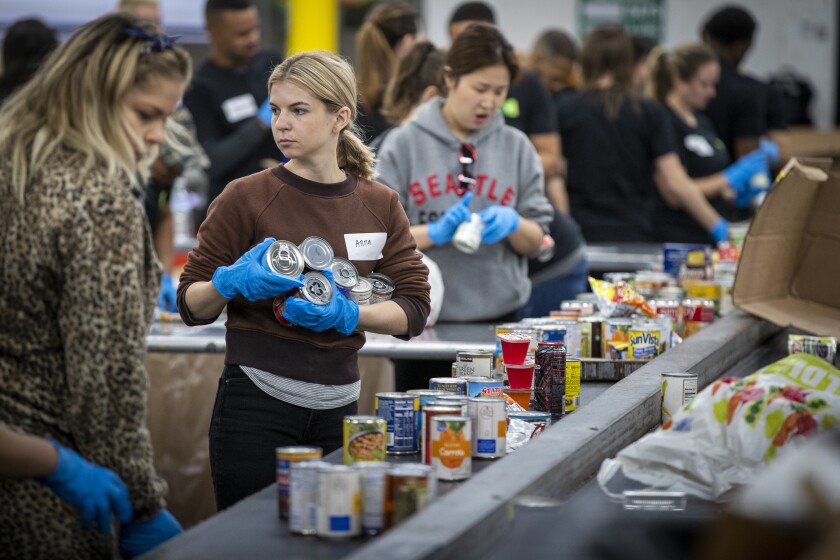Be sure to also visit Rich Cameron’s “Online Elsewhere,” available from the main menu.

Prominent Latinos urge NYT to keep publishing Spanish opinion journalism
Over 100 prominent figures in Latin America are urging The New York Times' publisher to not stop publishing Spanish-written opinion journalism, according to a letter shared exclusively with Axios. The Times has not published any op-eds that were originally written in Spanish since Sept. 28. The newspaper had been publishing from five to seven such pieces a week.
The big picture: The Times launched its Spanish platform — "NYT en Español" — in 2016, along with a bureau in Mexico, in an effort to expand its news coverage globally. During its existence, the section published around 10 to 15 stories a day, some written in Spanish and some translated from English.

The Lead: ‘You’re not supposed to know everything’: Current and former student editors share advice on leadership roles
A dozen student editors from around the U.S. have tips to share with peers on time management, delegating responsibilities and setting boundaries. What do they wish they’d known before taking on an editing or leadership position? A collection of responses is below, with tips on time management, setting boundaries and delegating responsibilities. Some students requested anonymity to speak candidly about their former roles.
Covering the tragedy in Surfside from near and far
Early Thursday morning a residential condo collapsed in Surfside, a town just north of Miami Beach, in Florida. Joey Flechas, a reporter for the Miami Herald, was quickly on the scene, since he lives 10 minutes away from the building.
“I’m a member of this community who has talked to some of these first responders, politicians and neighbors before,” he said. “And I’m just one of many of us who can say the same thing.”
Since the collapse, Flechas and his colleagues have worked tirelessly to cover the story—the state of the rescue mission; the identities of the deceased and the missing. [ Read full article ]
How journalism students are filling gaps in local news
As the local news crisis grows, staffs are thinning out and gaps in coverage are widening. But reinforcements are coming — journalism students doing the work that would otherwise go undone. [ Read full article ]

Local news surging with burst of young talent from the School of Communication
Reid Campbell was just beginning his job as a producer at WDBJ-TV in Roanoke when he was tasked with filling in for the 6 p.m. show. He managed the content, stacked the show, and then, in an ironic twist of fate, handed the rundown to anchor Robin Reed. Just a few weeks earlier, Campbell had been a Virginia Tech senior handing in assignments to Reed, a professor of practice in the School of Communication. Now as producer, Campbell was giving the 40-year WDBJ veteran his assignment for the night. [ Read full article ]

Beyond Peril: how The New York Times responds when a journalist's safety is compromised
Joshua Rashaad McFadden,30, a freelance photographer, was trying to leave. He was covering protests last month in Brooklyn Center, Minn., for The New York Times after Daunte Wright, an unarmed Black man, had been fatally shot by a police officer during a traffic stop. McFadden had just spent an exhausting night dodging tear gas and pepper spray. Now, he just wanted to go home. About 15 police officers stood in his way. As he was trying to exit the area, the officers surrounded the car he was in with another photographer, he said, first beating on the windows with batons and then entering the car and striking his legs and camera lens. They did not believe him when he said he was a journalist. It was only after the other photographer — white, he noted — vouched for his credentials that they let him go. [ Read full article ]

A new California Bill has spurned a battle between journalists and law enforcement
The bill would allow journalists to operate in closed areas (an unprecedented step) including riot areas after a dispersal order has been issued. However, law enforcement officials pressured lawmakers to add an amendment last week that would require journalists to get permission from a commanding officer before being allowed in closed areas, which, for the journalists that endorsed the bill, is considered a step backward. [ Read full article ]

Moorefield, W.Va.: A town without news — for a day
What happens if your community loses its local newspaper? Readers of the Moorefield Examiner in West Virginia got an unexpected preview in the June 2 edition when the family-owned Hardy County weekly newspaper ran a blank front page under the banner headline: Is No News Really Good News? [ Read full article ]

Opinion: ‘Moral posturing’: Fox News’s Chris Wallace criticizes the shunning of ‘big lie’ proponents
The guy from Fox News doesn’t agree with the guy from CNN. “I don’t think moral posturing goes well with newsgathering,” Chris Wallace, host of “Fox News Sunday,” told Politico Playbook. He was rebutting comments from CNN’s Jake Tapper, co-anchor of competing Sunday show “State of the Union.” [ Read full article ]

How to report LGBT+ stories with confidence
Sports Media LGBT+ recently launched ‘Rainbow Ready’ – a new resources pack for communicating LGBT+ inclusion in sport. The 14-page document lays out a strategy that anyone working in a sports media role can adopt to help make lesbian, gay, bi and trans people feel welcome and included. In addition, a set of media guidelines is provided to assist press officers, editors and journalists in producing related content. [ Read full article ]

If you value local journalism, here's an opportunity for you to help
The Daily Herald, which covers the suburbs of Chicago, kicked off its 2020 Report for the Suburbs Campaign, a yearlong fund drive coordinated with the nonprofit Report for America. The paper hired three new reporters that will focus on news in the local communities beginning this summer. [ Read full article ]

What journalism jobs are going to grow?
Most journalism jobs today require critical thinking and excellent writing, plus strong social media skills. That’s obvious. But what about the jobs of tomorrow? [ Read full article ]

Advice for using mobile journalism techniques in sports reporting
Make the most of your smartphone when interviewing players, telling their stories and reporting from the heart of the action [ Read full article ]

A guide to Slack for journalism students (and lecturers)
Slack is a professional chat app used widely in the media industry to organise projects. It has a number of advantages over other options for communicating between colleagues, whether that’s chat apps such as WhatsApp, or traditional email. [ Read full article ]

College students don’t have enough money to eat. Their classmates are feeding them
Although not "journalism news," this is about students who rely on their college's food bank when they're hungry. This has been the subject of several JACC colleges' news articles this semester.

Podcast: When facts can’t help
(Columbia School of Journalism, December 6, 2019)
Democracy is reliant on facts, but fact-checking no longer seem to dispel misleading information. As a prelude to next week’s Disinfo 2020: Prepping the Press conference, Kyle Pope, editor and publisher of CJR, discusses disinformation and the failings of the fact-checking industry with Emily Bell, the director of the Tow Center for Digital Journalism at Columbia, and media literacy expert Whitney Phillips, an assistant professor at Syracuse University.

FAQ: How can journalism lecturers keep up with a fast-changing industry?
(Online Journalism Blog, December 7, 2019)
Trends in journalism are always evolving, so how can educators keep up? Here's a few tips for topics such as the rise in popularity of podcasting, importance of data skills, etc. "That means teaching students how to choose what skills to learn; it means helping them to find the best sources to do so; it means giving them the skills to adapt to new forms of storytelling, and continue to do so as genres emerge and develop." - see full article

